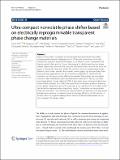Ultra-compact nonvolatile phase shifter based on electrically reprogrammable transparent phase change materials
Author(s)
Ríos, Carlos; Du, Qingyang; Zhang, Yifei; Popescu, Cosmin-Constantin; Shalaginov, Mikhail Y.; Miller, Paul; Roberts, Christopher; Kang, Myungkoo; Richardson, Kathleen A.; Gu, Tian; Vitale, Steven A.; Hu, Juejun; ... Show more Show less
Download43074_2022_Article_70.pdf (4.929Mb)
Publisher with Creative Commons License
Publisher with Creative Commons License
Creative Commons Attribution
Terms of use
Metadata
Show full item recordAbstract
Abstract
Optical phase shifters constitute the fundamental building blocks that enable programmable photonic integrated circuits (PICs)—the cornerstone of on-chip classical and quantum optical technologies [1, 2]. Thus far, carrier modulation and thermo-optical effect are the chosen phenomena for ultrafast and low-loss phase shifters, respectively; however, the state and information they carry are lost once the power is turned off—they are volatile. The volatility not only compromises energy efficiency due to their demand for constant power supply, but also precludes them from emerging applications such as in-memory computing. To circumvent this limitation, we introduce a phase shifting mechanism that exploits the nonvolatile refractive index modulation upon structural phase transition of Sb2Se3, a bi-state transparent phase change material (PCM). A zero-static power and electrically-driven phase shifter is realized on a CMOS-backend silicon-on-insulator platform, featuring record phase modulation up to 0.09 π/µm and a low insertion loss of 0.3 dB/π, which can be further improved upon streamlined design. Furthermore, we demonstrate phase and extinction ratio trimming of ring resonators and pioneer a one-step partial amorphization scheme to enhance speed and energy efficiency of PCM devices. A diverse cohort of programmable photonic devices is demonstrated based on the ultra-compact PCM phase shifter.
Date issued
2022-10-26Department
Massachusetts Institute of Technology. Department of Materials Science and Engineering; Lincoln Laboratory; MIT Materials Research LaboratoryPublisher
Springer Nature Singapore
Citation
PhotoniX. 2022 Oct 26;3(1):26
Version: Final published version